Strategic Management of Tesco: An Analysis of Business Strategy
VerifiedAdded on 2023/06/21
|37
|8967
|307
Report
AI Summary
This report provides a comprehensive analysis of Tesco's strategic management, employing various strategic models and frameworks. It begins with an overview of Tesco's history, size, and industry position, followed by an examination of the external environment using PESTLE and Porter's Five Forces to assess macro and micro environmental factors affecting the business. The internal environment is evaluated through vision, mission, values, culture, VRIO analysis, and portfolio analysis, alongside a review of Tesco's financial performance. The report includes a SWOT analysis to identify strengths, weaknesses, opportunities, and threats, leading to an exploration of strategic options using Porter's Generic Strategies and the Ansoff Matrix. The analysis concludes with recommendations derived from TOWS and SAFe frameworks, aiming to enhance Tesco's strategic planning and competitive positioning. Desklib provides access to this and other solved assignments for students.
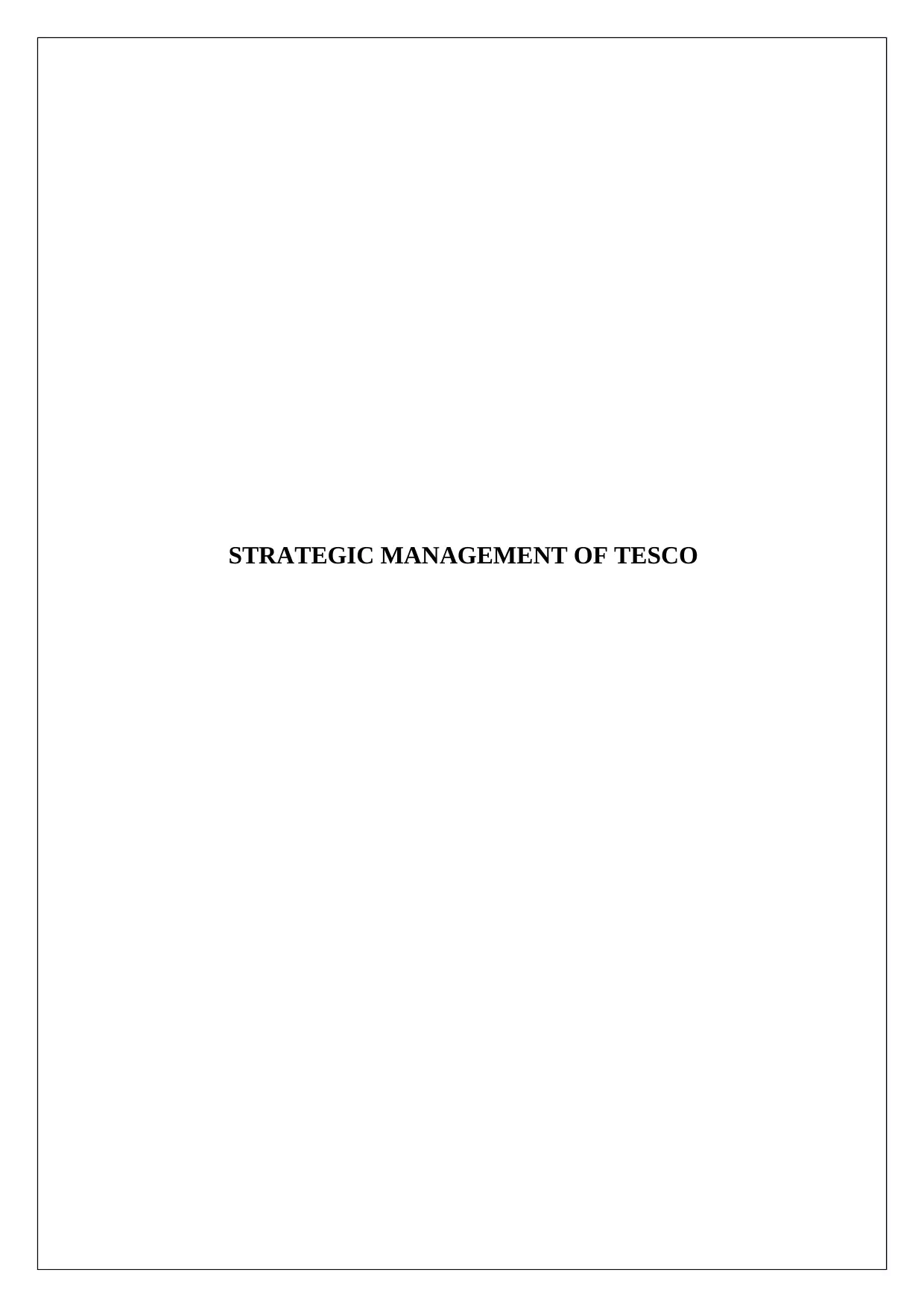
STRATEGIC MANAGEMENT OF TESCO
Paraphrase This Document
Need a fresh take? Get an instant paraphrase of this document with our AI Paraphraser
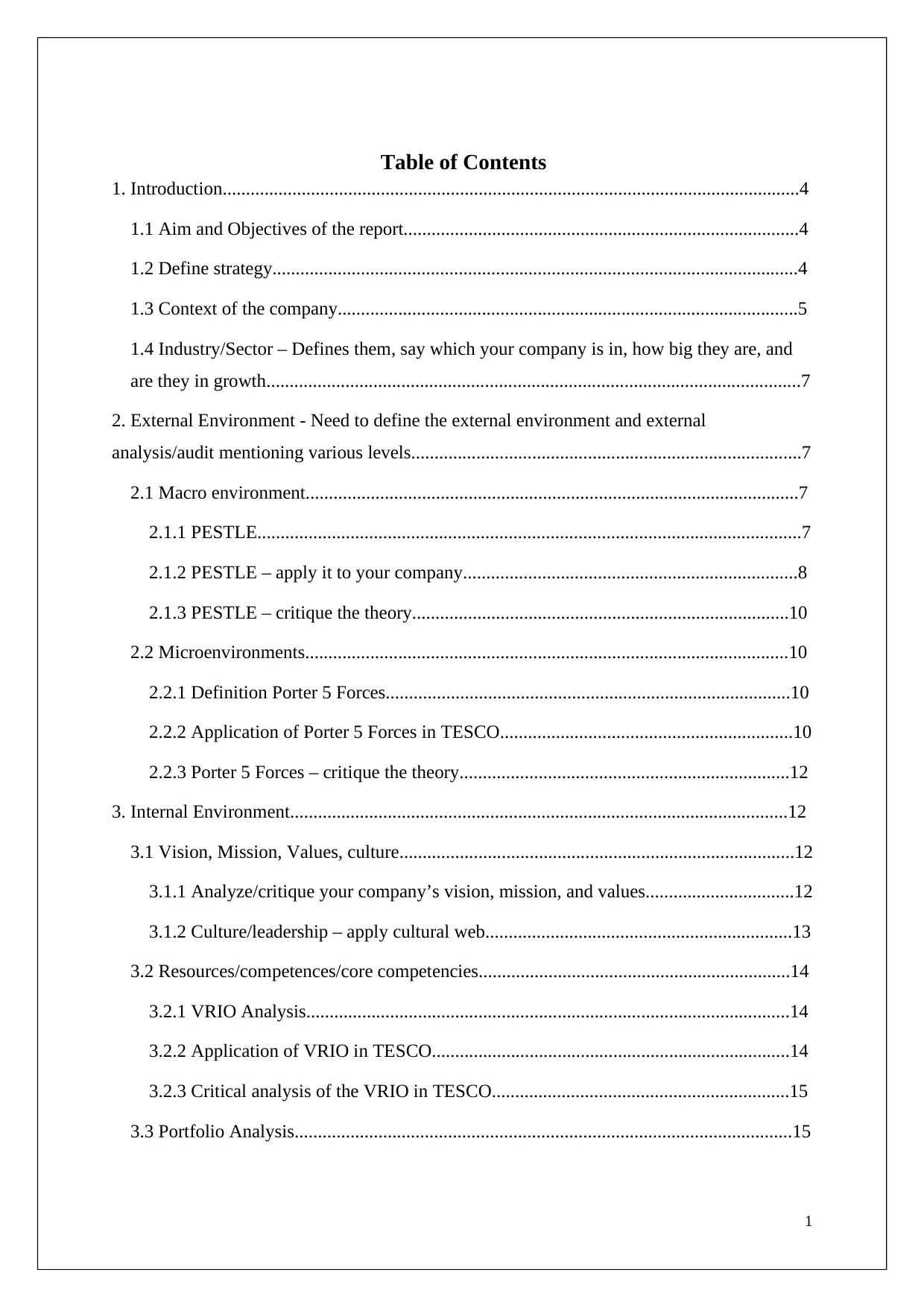
Table of Contents
1. Introduction............................................................................................................................4
1.1 Aim and Objectives of the report.....................................................................................4
1.2 Define strategy.................................................................................................................4
1.3 Context of the company...................................................................................................5
1.4 Industry/Sector – Defines them, say which your company is in, how big they are, and
are they in growth...................................................................................................................7
2. External Environment - Need to define the external environment and external
analysis/audit mentioning various levels....................................................................................7
2.1 Macro environment..........................................................................................................7
2.1.1 PESTLE.....................................................................................................................7
2.1.2 PESTLE – apply it to your company........................................................................8
2.1.3 PESTLE – critique the theory.................................................................................10
2.2 Microenvironments........................................................................................................10
2.2.1 Definition Porter 5 Forces.......................................................................................10
2.2.2 Application of Porter 5 Forces in TESCO...............................................................10
2.2.3 Porter 5 Forces – critique the theory.......................................................................12
3. Internal Environment...........................................................................................................12
3.1 Vision, Mission, Values, culture.....................................................................................12
3.1.1 Analyze/critique your company’s vision, mission, and values................................12
3.1.2 Culture/leadership – apply cultural web..................................................................13
3.2 Resources/competences/core competencies...................................................................14
3.2.1 VRIO Analysis........................................................................................................14
3.2.2 Application of VRIO in TESCO.............................................................................14
3.2.3 Critical analysis of the VRIO in TESCO................................................................15
3.3 Portfolio Analysis...........................................................................................................15
1
1. Introduction............................................................................................................................4
1.1 Aim and Objectives of the report.....................................................................................4
1.2 Define strategy.................................................................................................................4
1.3 Context of the company...................................................................................................5
1.4 Industry/Sector – Defines them, say which your company is in, how big they are, and
are they in growth...................................................................................................................7
2. External Environment - Need to define the external environment and external
analysis/audit mentioning various levels....................................................................................7
2.1 Macro environment..........................................................................................................7
2.1.1 PESTLE.....................................................................................................................7
2.1.2 PESTLE – apply it to your company........................................................................8
2.1.3 PESTLE – critique the theory.................................................................................10
2.2 Microenvironments........................................................................................................10
2.2.1 Definition Porter 5 Forces.......................................................................................10
2.2.2 Application of Porter 5 Forces in TESCO...............................................................10
2.2.3 Porter 5 Forces – critique the theory.......................................................................12
3. Internal Environment...........................................................................................................12
3.1 Vision, Mission, Values, culture.....................................................................................12
3.1.1 Analyze/critique your company’s vision, mission, and values................................12
3.1.2 Culture/leadership – apply cultural web..................................................................13
3.2 Resources/competences/core competencies...................................................................14
3.2.1 VRIO Analysis........................................................................................................14
3.2.2 Application of VRIO in TESCO.............................................................................14
3.2.3 Critical analysis of the VRIO in TESCO................................................................15
3.3 Portfolio Analysis...........................................................................................................15
1
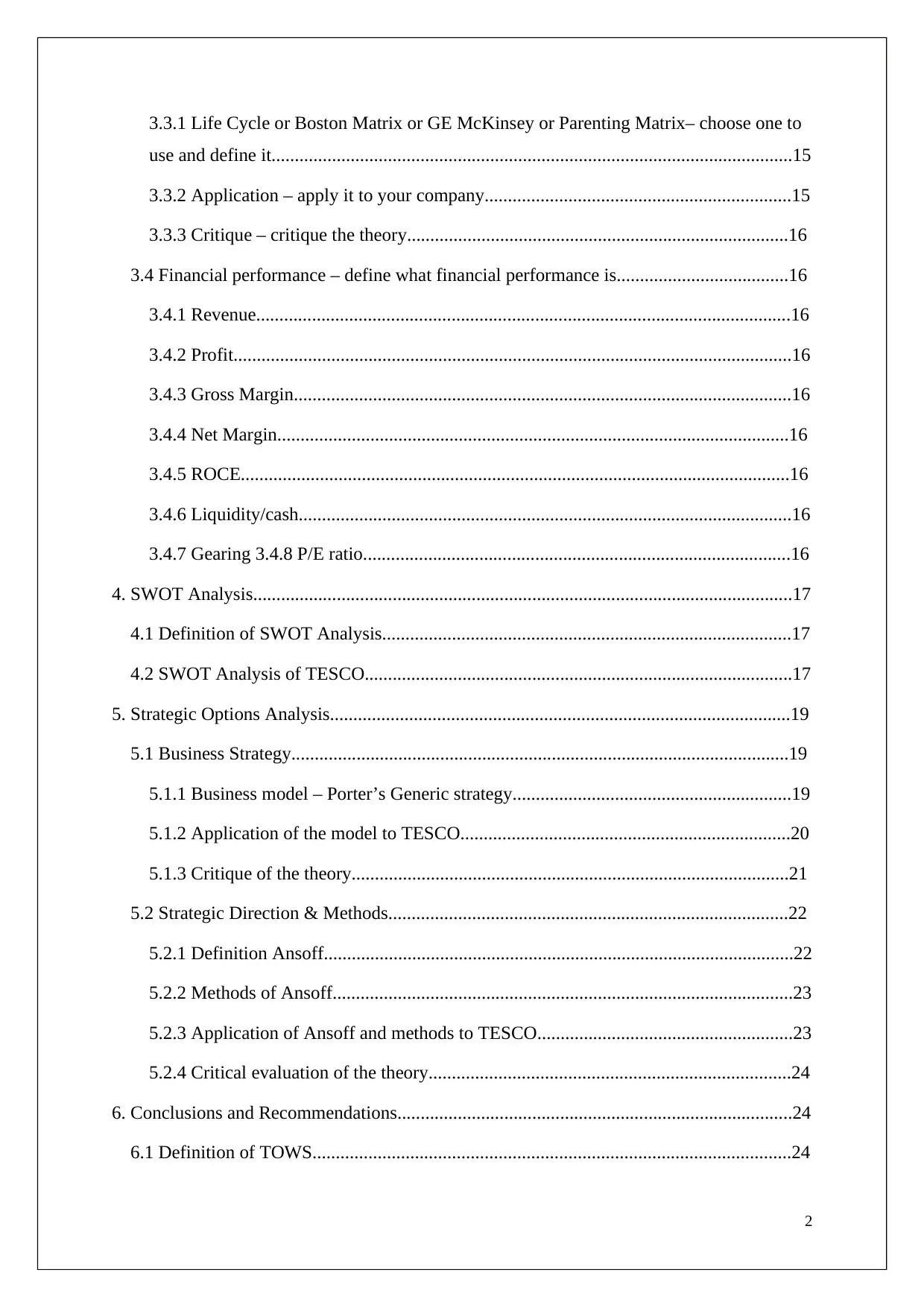
3.3.1 Life Cycle or Boston Matrix or GE McKinsey or Parenting Matrix– choose one to
use and define it................................................................................................................15
3.3.2 Application – apply it to your company..................................................................15
3.3.3 Critique – critique the theory..................................................................................16
3.4 Financial performance – define what financial performance is.....................................16
3.4.1 Revenue...................................................................................................................16
3.4.2 Profit........................................................................................................................16
3.4.3 Gross Margin...........................................................................................................16
3.4.4 Net Margin..............................................................................................................16
3.4.5 ROCE......................................................................................................................16
3.4.6 Liquidity/cash..........................................................................................................16
3.4.7 Gearing 3.4.8 P/E ratio............................................................................................16
4. SWOT Analysis....................................................................................................................17
4.1 Definition of SWOT Analysis........................................................................................17
4.2 SWOT Analysis of TESCO............................................................................................17
5. Strategic Options Analysis...................................................................................................19
5.1 Business Strategy...........................................................................................................19
5.1.1 Business model – Porter’s Generic strategy............................................................19
5.1.2 Application of the model to TESCO.......................................................................20
5.1.3 Critique of the theory..............................................................................................21
5.2 Strategic Direction & Methods......................................................................................22
5.2.1 Definition Ansoff.....................................................................................................22
5.2.2 Methods of Ansoff...................................................................................................23
5.2.3 Application of Ansoff and methods to TESCO.......................................................23
5.2.4 Critical evaluation of the theory..............................................................................24
6. Conclusions and Recommendations.....................................................................................24
6.1 Definition of TOWS.......................................................................................................24
2
use and define it................................................................................................................15
3.3.2 Application – apply it to your company..................................................................15
3.3.3 Critique – critique the theory..................................................................................16
3.4 Financial performance – define what financial performance is.....................................16
3.4.1 Revenue...................................................................................................................16
3.4.2 Profit........................................................................................................................16
3.4.3 Gross Margin...........................................................................................................16
3.4.4 Net Margin..............................................................................................................16
3.4.5 ROCE......................................................................................................................16
3.4.6 Liquidity/cash..........................................................................................................16
3.4.7 Gearing 3.4.8 P/E ratio............................................................................................16
4. SWOT Analysis....................................................................................................................17
4.1 Definition of SWOT Analysis........................................................................................17
4.2 SWOT Analysis of TESCO............................................................................................17
5. Strategic Options Analysis...................................................................................................19
5.1 Business Strategy...........................................................................................................19
5.1.1 Business model – Porter’s Generic strategy............................................................19
5.1.2 Application of the model to TESCO.......................................................................20
5.1.3 Critique of the theory..............................................................................................21
5.2 Strategic Direction & Methods......................................................................................22
5.2.1 Definition Ansoff.....................................................................................................22
5.2.2 Methods of Ansoff...................................................................................................23
5.2.3 Application of Ansoff and methods to TESCO.......................................................23
5.2.4 Critical evaluation of the theory..............................................................................24
6. Conclusions and Recommendations.....................................................................................24
6.1 Definition of TOWS.......................................................................................................24
2
⊘ This is a preview!⊘
Do you want full access?
Subscribe today to unlock all pages.

Trusted by 1+ million students worldwide

6.1.1 Application of TOWS..............................................................................................24
6.1.2 Critical evaluation of the model..............................................................................25
6.2 Definition of SAFe.........................................................................................................25
6.2.1 Application of SAFe................................................................................................26
6.2.2 Critical evaluation of the model..............................................................................26
6.3 Conclusion......................................................................................................................26
6.4 Recommendations..........................................................................................................26
6.5 Balanced Scorecard........................................................................................................27
References................................................................................................................................30
Appendices...............................................................................................................................34
Appendix 1: History of TESCO...........................................................................................34
3
6.1.2 Critical evaluation of the model..............................................................................25
6.2 Definition of SAFe.........................................................................................................25
6.2.1 Application of SAFe................................................................................................26
6.2.2 Critical evaluation of the model..............................................................................26
6.3 Conclusion......................................................................................................................26
6.4 Recommendations..........................................................................................................26
6.5 Balanced Scorecard........................................................................................................27
References................................................................................................................................30
Appendices...............................................................................................................................34
Appendix 1: History of TESCO...........................................................................................34
3
Paraphrase This Document
Need a fresh take? Get an instant paraphrase of this document with our AI Paraphraser
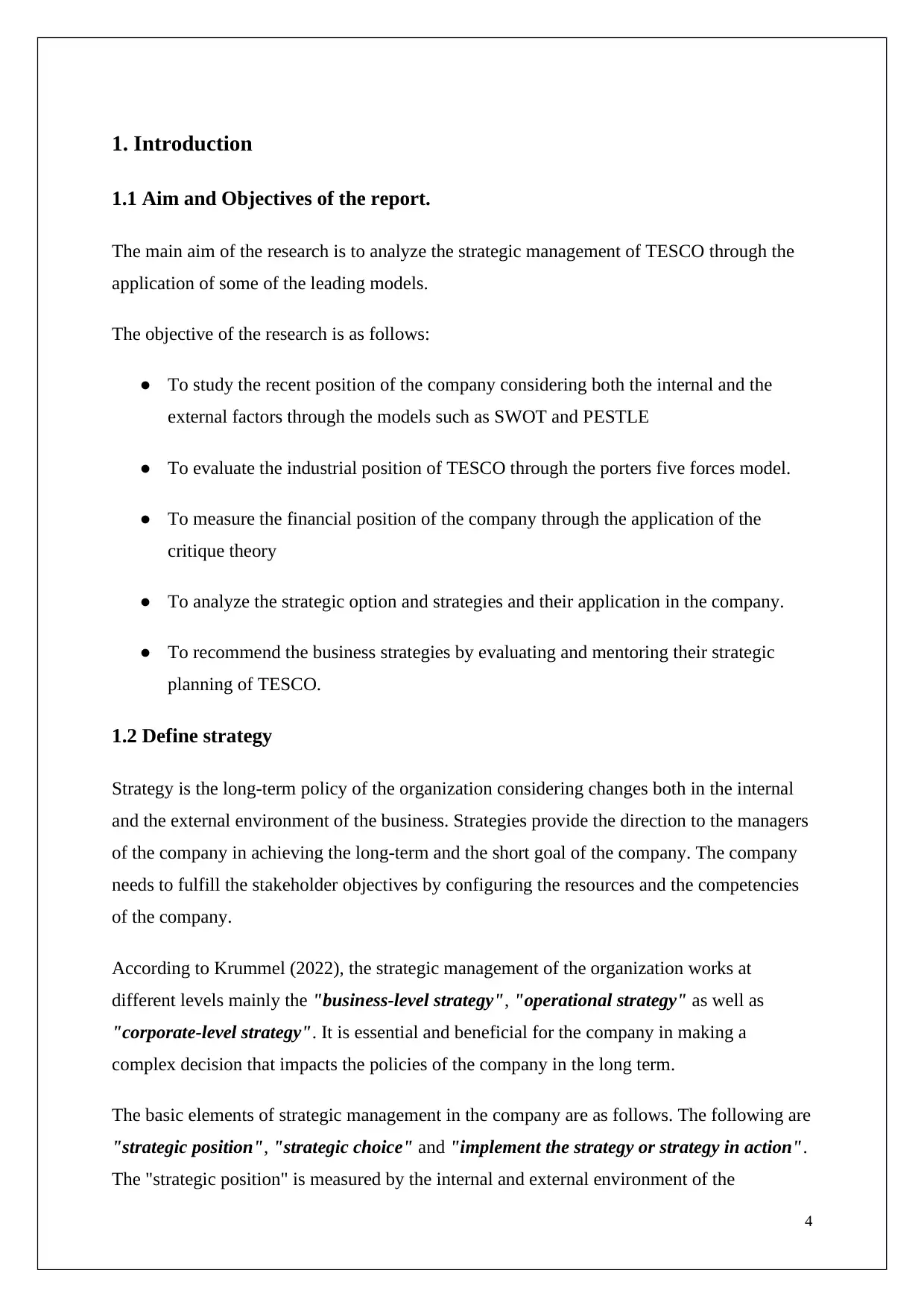
1. Introduction
1.1 Aim and Objectives of the report.
The main aim of the research is to analyze the strategic management of TESCO through the
application of some of the leading models.
The objective of the research is as follows:
● To study the recent position of the company considering both the internal and the
external factors through the models such as SWOT and PESTLE
● To evaluate the industrial position of TESCO through the porters five forces model.
● To measure the financial position of the company through the application of the
critique theory
● To analyze the strategic option and strategies and their application in the company.
● To recommend the business strategies by evaluating and mentoring their strategic
planning of TESCO.
1.2 Define strategy
Strategy is the long-term policy of the organization considering changes both in the internal
and the external environment of the business. Strategies provide the direction to the managers
of the company in achieving the long-term and the short goal of the company. The company
needs to fulfill the stakeholder objectives by configuring the resources and the competencies
of the company.
According to Krummel (2022), the strategic management of the organization works at
different levels mainly the "business-level strategy", "operational strategy" as well as
"corporate-level strategy". It is essential and beneficial for the company in making a
complex decision that impacts the policies of the company in the long term.
The basic elements of strategic management in the company are as follows. The following are
"strategic position", "strategic choice" and "implement the strategy or strategy in action".
The "strategic position" is measured by the internal and external environment of the
4
1.1 Aim and Objectives of the report.
The main aim of the research is to analyze the strategic management of TESCO through the
application of some of the leading models.
The objective of the research is as follows:
● To study the recent position of the company considering both the internal and the
external factors through the models such as SWOT and PESTLE
● To evaluate the industrial position of TESCO through the porters five forces model.
● To measure the financial position of the company through the application of the
critique theory
● To analyze the strategic option and strategies and their application in the company.
● To recommend the business strategies by evaluating and mentoring their strategic
planning of TESCO.
1.2 Define strategy
Strategy is the long-term policy of the organization considering changes both in the internal
and the external environment of the business. Strategies provide the direction to the managers
of the company in achieving the long-term and the short goal of the company. The company
needs to fulfill the stakeholder objectives by configuring the resources and the competencies
of the company.
According to Krummel (2022), the strategic management of the organization works at
different levels mainly the "business-level strategy", "operational strategy" as well as
"corporate-level strategy". It is essential and beneficial for the company in making a
complex decision that impacts the policies of the company in the long term.
The basic elements of strategic management in the company are as follows. The following are
"strategic position", "strategic choice" and "implement the strategy or strategy in action".
The "strategic position" is measured by the internal and external environment of the
4
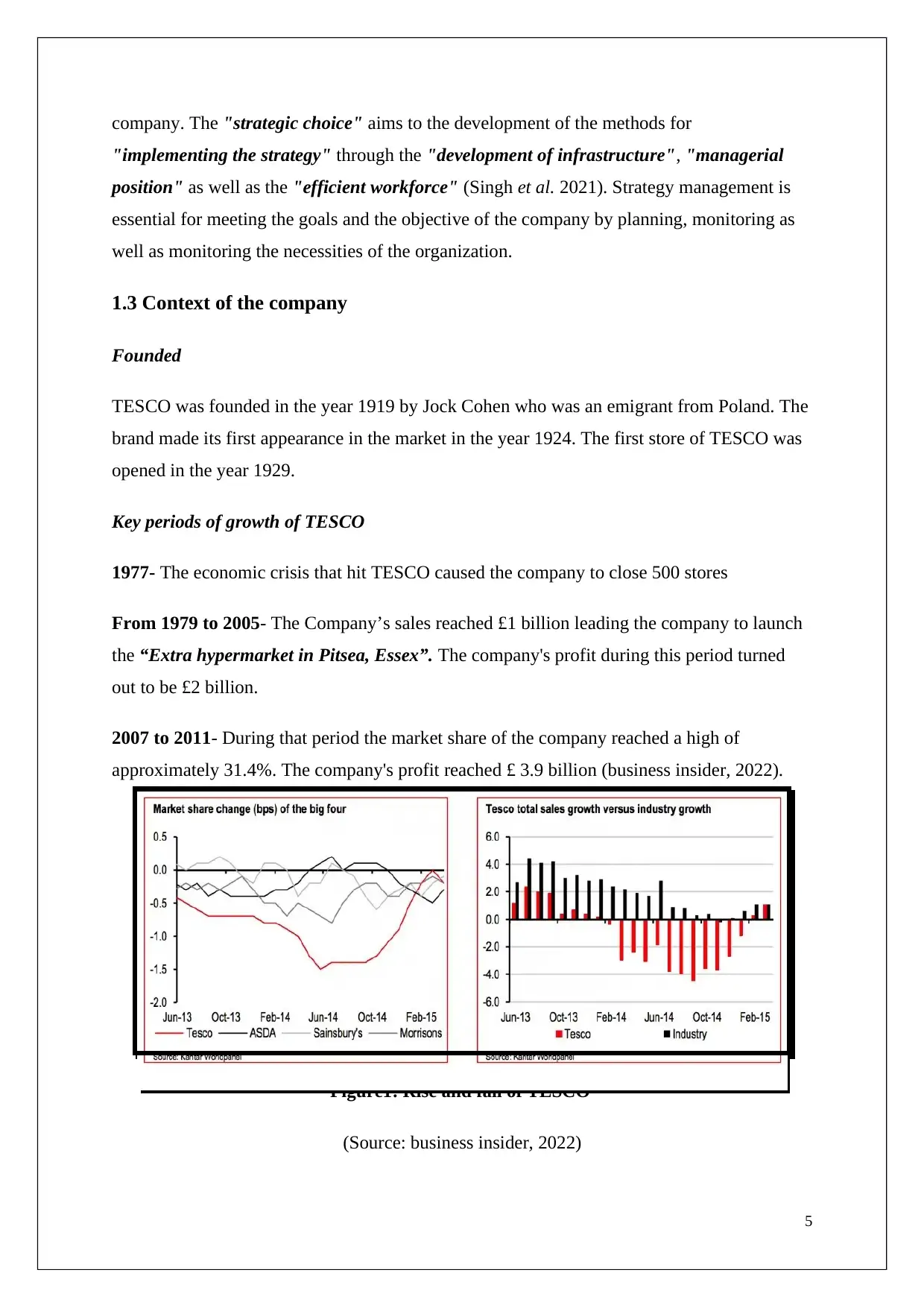
company. The "strategic choice" aims to the development of the methods for
"implementing the strategy" through the "development of infrastructure", "managerial
position" as well as the "efficient workforce" (Singh et al. 2021). Strategy management is
essential for meeting the goals and the objective of the company by planning, monitoring as
well as monitoring the necessities of the organization.
1.3 Context of the company
Founded
TESCO was founded in the year 1919 by Jock Cohen who was an emigrant from Poland. The
brand made its first appearance in the market in the year 1924. The first store of TESCO was
opened in the year 1929.
Key periods of growth of TESCO
1977- The economic crisis that hit TESCO caused the company to close 500 stores
From 1979 to 2005- The Company’s sales reached £1 billion leading the company to launch
the “Extra hypermarket in Pitsea, Essex”. The company's profit during this period turned
out to be £2 billion.
2007 to 2011- During that period the market share of the company reached a high of
approximately 31.4%. The company's profit reached £ 3.9 billion (business insider, 2022).
Figure1: Rise and fall of TESCO
(Source: business insider, 2022)
5
"implementing the strategy" through the "development of infrastructure", "managerial
position" as well as the "efficient workforce" (Singh et al. 2021). Strategy management is
essential for meeting the goals and the objective of the company by planning, monitoring as
well as monitoring the necessities of the organization.
1.3 Context of the company
Founded
TESCO was founded in the year 1919 by Jock Cohen who was an emigrant from Poland. The
brand made its first appearance in the market in the year 1924. The first store of TESCO was
opened in the year 1929.
Key periods of growth of TESCO
1977- The economic crisis that hit TESCO caused the company to close 500 stores
From 1979 to 2005- The Company’s sales reached £1 billion leading the company to launch
the “Extra hypermarket in Pitsea, Essex”. The company's profit during this period turned
out to be £2 billion.
2007 to 2011- During that period the market share of the company reached a high of
approximately 31.4%. The company's profit reached £ 3.9 billion (business insider, 2022).
Figure1: Rise and fall of TESCO
(Source: business insider, 2022)
5
⊘ This is a preview!⊘
Do you want full access?
Subscribe today to unlock all pages.

Trusted by 1+ million students worldwide
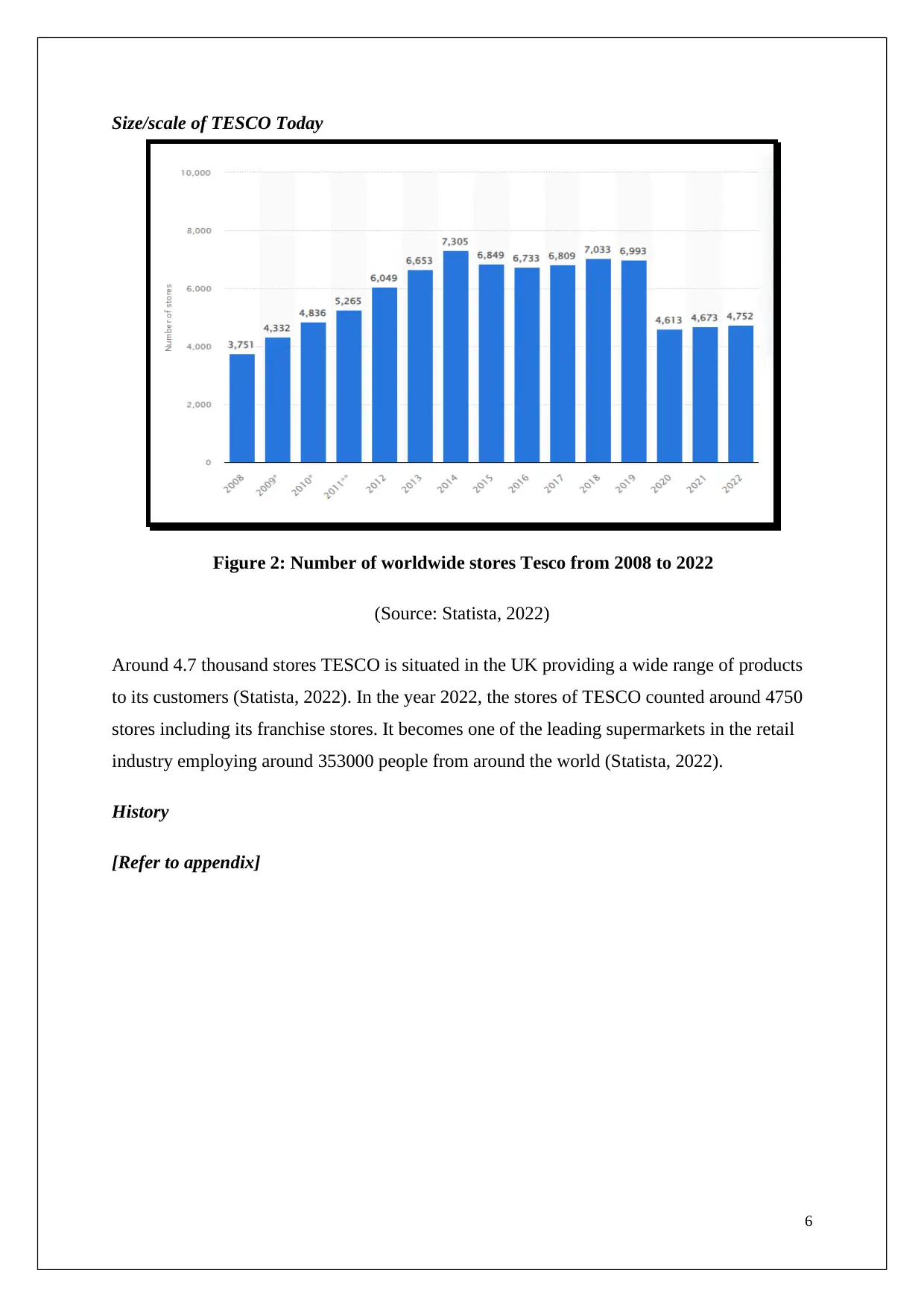
Size/scale of TESCO Today
Figure 2: Number of worldwide stores Tesco from 2008 to 2022
(Source: Statista, 2022)
Around 4.7 thousand stores TESCO is situated in the UK providing a wide range of products
to its customers (Statista, 2022). In the year 2022, the stores of TESCO counted around 4750
stores including its franchise stores. It becomes one of the leading supermarkets in the retail
industry employing around 353000 people from around the world (Statista, 2022).
History
[Refer to appendix]
6
Figure 2: Number of worldwide stores Tesco from 2008 to 2022
(Source: Statista, 2022)
Around 4.7 thousand stores TESCO is situated in the UK providing a wide range of products
to its customers (Statista, 2022). In the year 2022, the stores of TESCO counted around 4750
stores including its franchise stores. It becomes one of the leading supermarkets in the retail
industry employing around 353000 people from around the world (Statista, 2022).
History
[Refer to appendix]
6
Paraphrase This Document
Need a fresh take? Get an instant paraphrase of this document with our AI Paraphraser
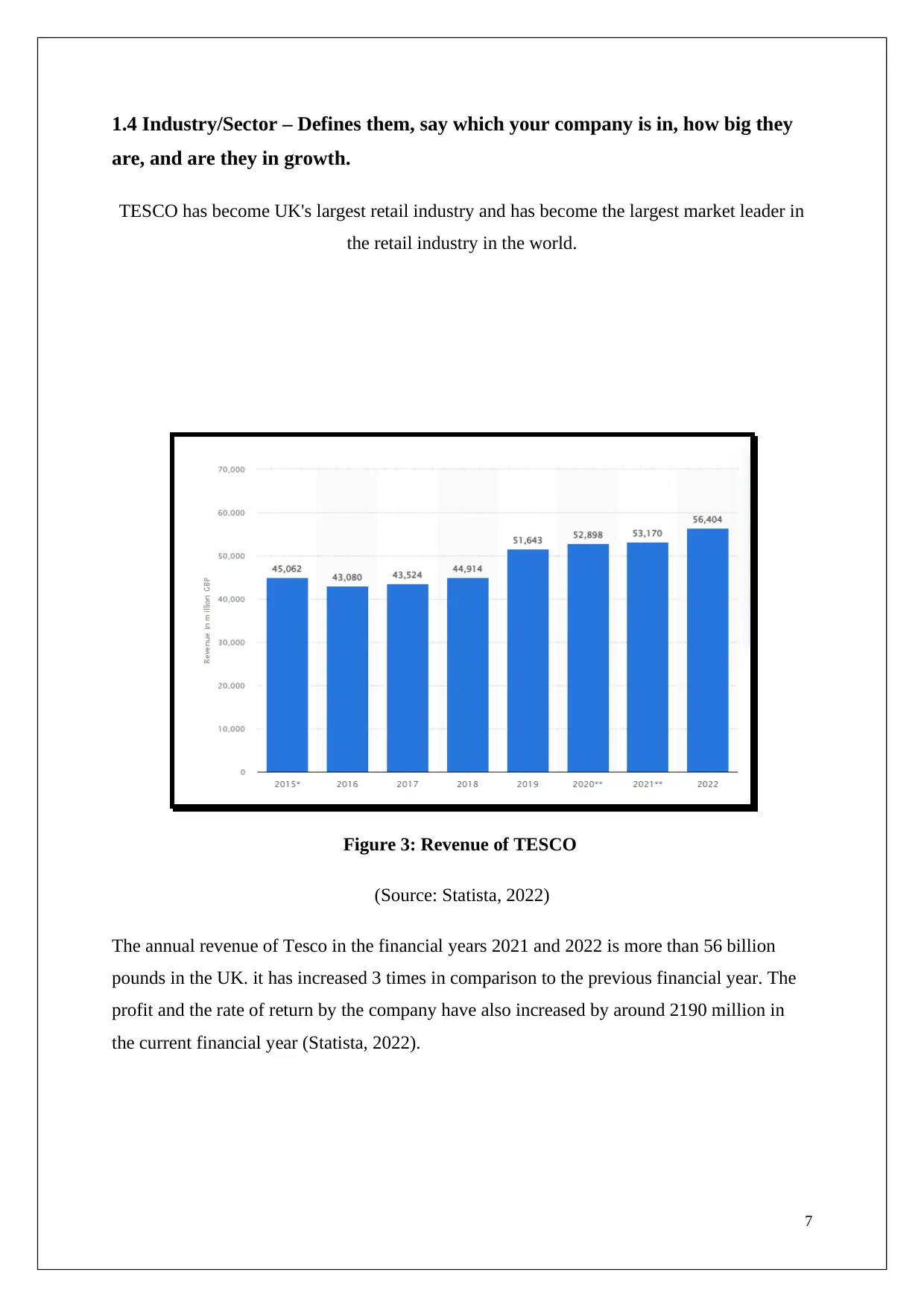
1.4 Industry/Sector – Defines them, say which your company is in, how big they
are, and are they in growth.
TESCO has become UK's largest retail industry and has become the largest market leader in
the retail industry in the world.
Figure 3: Revenue of TESCO
(Source: Statista, 2022)
The annual revenue of Tesco in the financial years 2021 and 2022 is more than 56 billion
pounds in the UK. it has increased 3 times in comparison to the previous financial year. The
profit and the rate of return by the company have also increased by around 2190 million in
the current financial year (Statista, 2022).
7
are, and are they in growth.
TESCO has become UK's largest retail industry and has become the largest market leader in
the retail industry in the world.
Figure 3: Revenue of TESCO
(Source: Statista, 2022)
The annual revenue of Tesco in the financial years 2021 and 2022 is more than 56 billion
pounds in the UK. it has increased 3 times in comparison to the previous financial year. The
profit and the rate of return by the company have also increased by around 2190 million in
the current financial year (Statista, 2022).
7
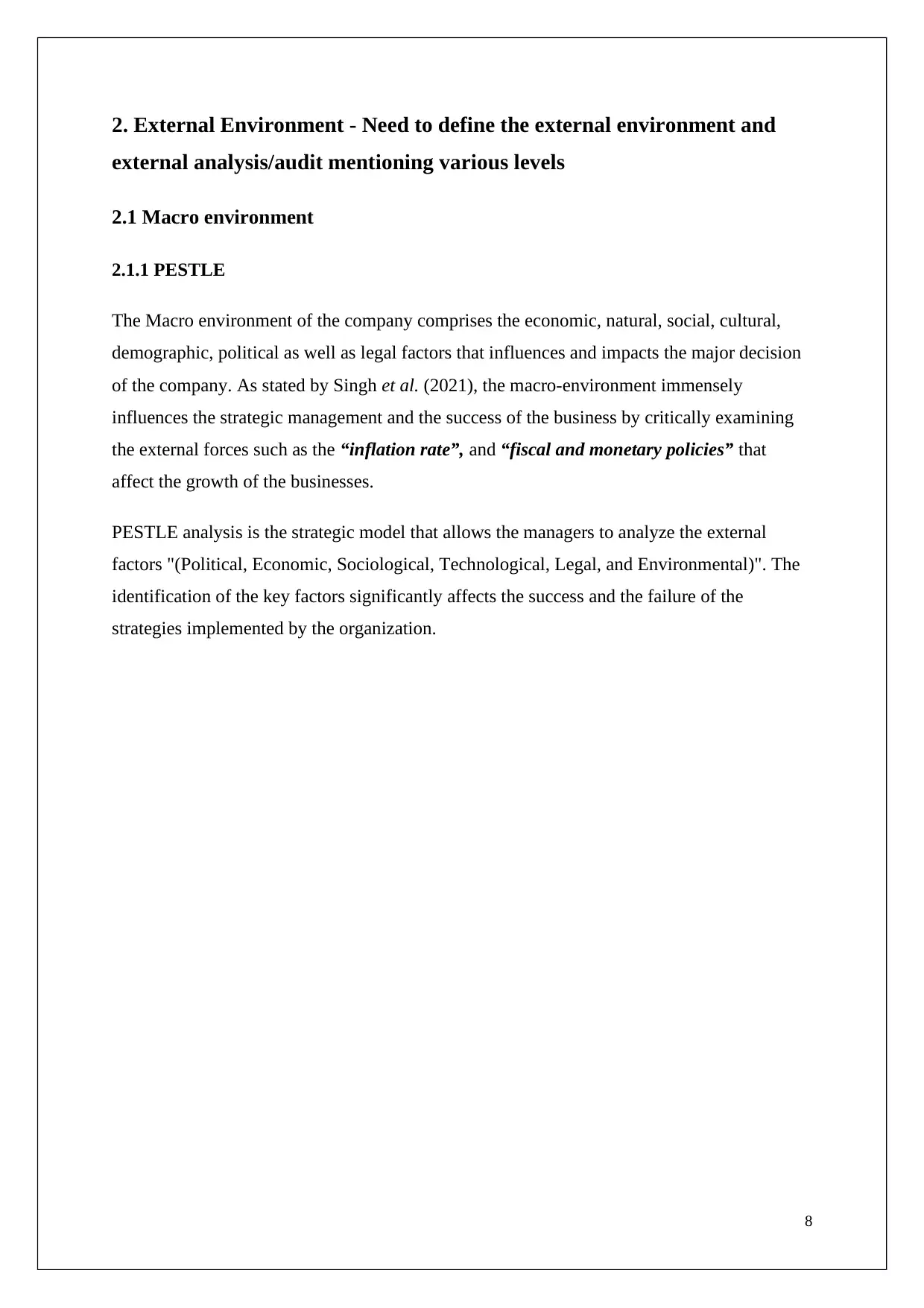
2. External Environment - Need to define the external environment and
external analysis/audit mentioning various levels
2.1 Macro environment
2.1.1 PESTLE
The Macro environment of the company comprises the economic, natural, social, cultural,
demographic, political as well as legal factors that influences and impacts the major decision
of the company. As stated by Singh et al. (2021), the macro-environment immensely
influences the strategic management and the success of the business by critically examining
the external forces such as the “inflation rate”, and “fiscal and monetary policies” that
affect the growth of the businesses.
PESTLE analysis is the strategic model that allows the managers to analyze the external
factors "(Political, Economic, Sociological, Technological, Legal, and Environmental)". The
identification of the key factors significantly affects the success and the failure of the
strategies implemented by the organization.
8
external analysis/audit mentioning various levels
2.1 Macro environment
2.1.1 PESTLE
The Macro environment of the company comprises the economic, natural, social, cultural,
demographic, political as well as legal factors that influences and impacts the major decision
of the company. As stated by Singh et al. (2021), the macro-environment immensely
influences the strategic management and the success of the business by critically examining
the external forces such as the “inflation rate”, and “fiscal and monetary policies” that
affect the growth of the businesses.
PESTLE analysis is the strategic model that allows the managers to analyze the external
factors "(Political, Economic, Sociological, Technological, Legal, and Environmental)". The
identification of the key factors significantly affects the success and the failure of the
strategies implemented by the organization.
8
⊘ This is a preview!⊘
Do you want full access?
Subscribe today to unlock all pages.

Trusted by 1+ million students worldwide
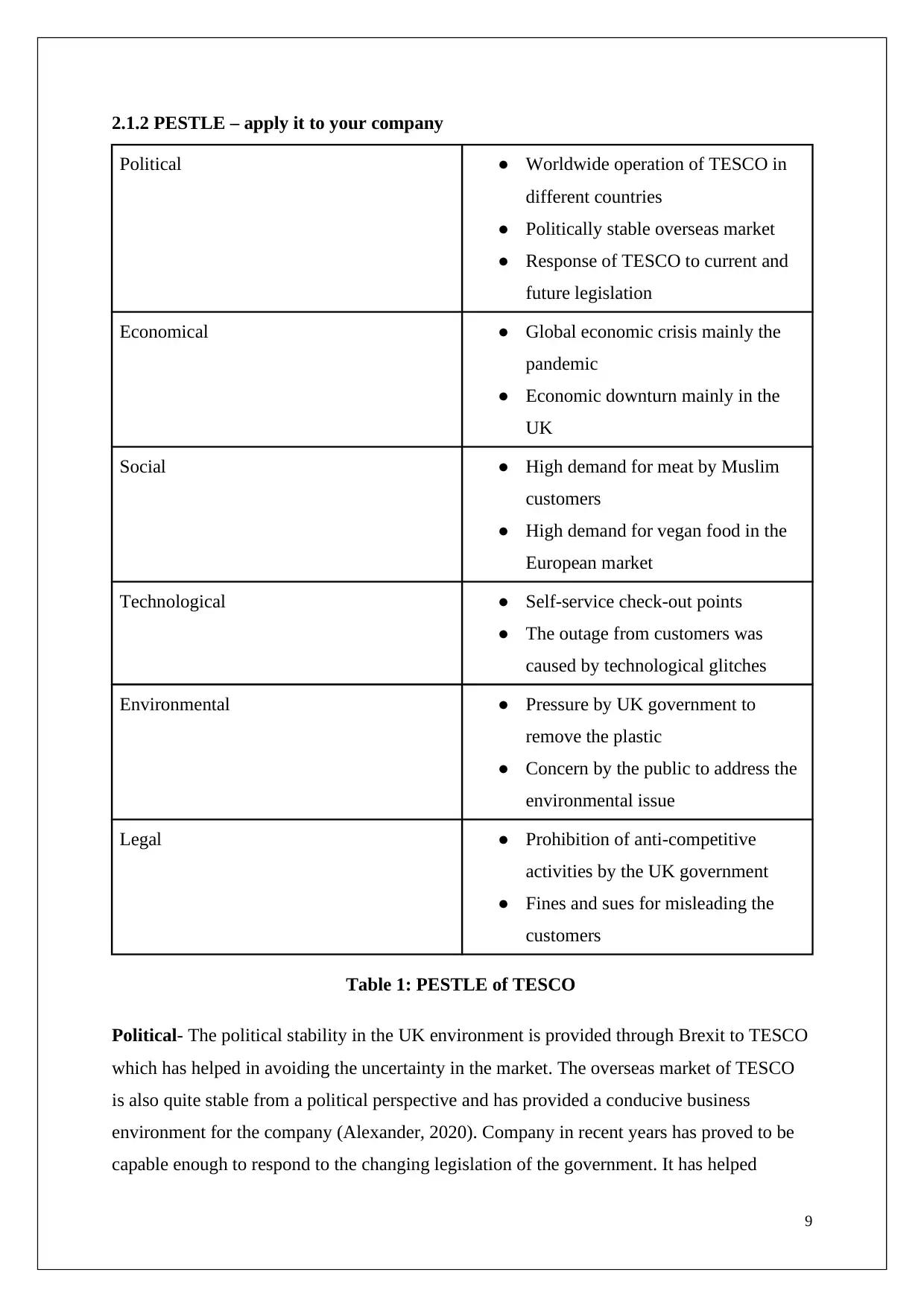
2.1.2 PESTLE – apply it to your company
Political ● Worldwide operation of TESCO in
different countries
● Politically stable overseas market
● Response of TESCO to current and
future legislation
Economical ● Global economic crisis mainly the
pandemic
● Economic downturn mainly in the
UK
Social ● High demand for meat by Muslim
customers
● High demand for vegan food in the
European market
Technological ● Self-service check-out points
● The outage from customers was
caused by technological glitches
Environmental ● Pressure by UK government to
remove the plastic
● Concern by the public to address the
environmental issue
Legal ● Prohibition of anti-competitive
activities by the UK government
● Fines and sues for misleading the
customers
Table 1: PESTLE of TESCO
Political- The political stability in the UK environment is provided through Brexit to TESCO
which has helped in avoiding the uncertainty in the market. The overseas market of TESCO
is also quite stable from a political perspective and has provided a conducive business
environment for the company (Alexander, 2020). Company in recent years has proved to be
capable enough to respond to the changing legislation of the government. It has helped
9
Political ● Worldwide operation of TESCO in
different countries
● Politically stable overseas market
● Response of TESCO to current and
future legislation
Economical ● Global economic crisis mainly the
pandemic
● Economic downturn mainly in the
UK
Social ● High demand for meat by Muslim
customers
● High demand for vegan food in the
European market
Technological ● Self-service check-out points
● The outage from customers was
caused by technological glitches
Environmental ● Pressure by UK government to
remove the plastic
● Concern by the public to address the
environmental issue
Legal ● Prohibition of anti-competitive
activities by the UK government
● Fines and sues for misleading the
customers
Table 1: PESTLE of TESCO
Political- The political stability in the UK environment is provided through Brexit to TESCO
which has helped in avoiding the uncertainty in the market. The overseas market of TESCO
is also quite stable from a political perspective and has provided a conducive business
environment for the company (Alexander, 2020). Company in recent years has proved to be
capable enough to respond to the changing legislation of the government. It has helped
9
Paraphrase This Document
Need a fresh take? Get an instant paraphrase of this document with our AI Paraphraser
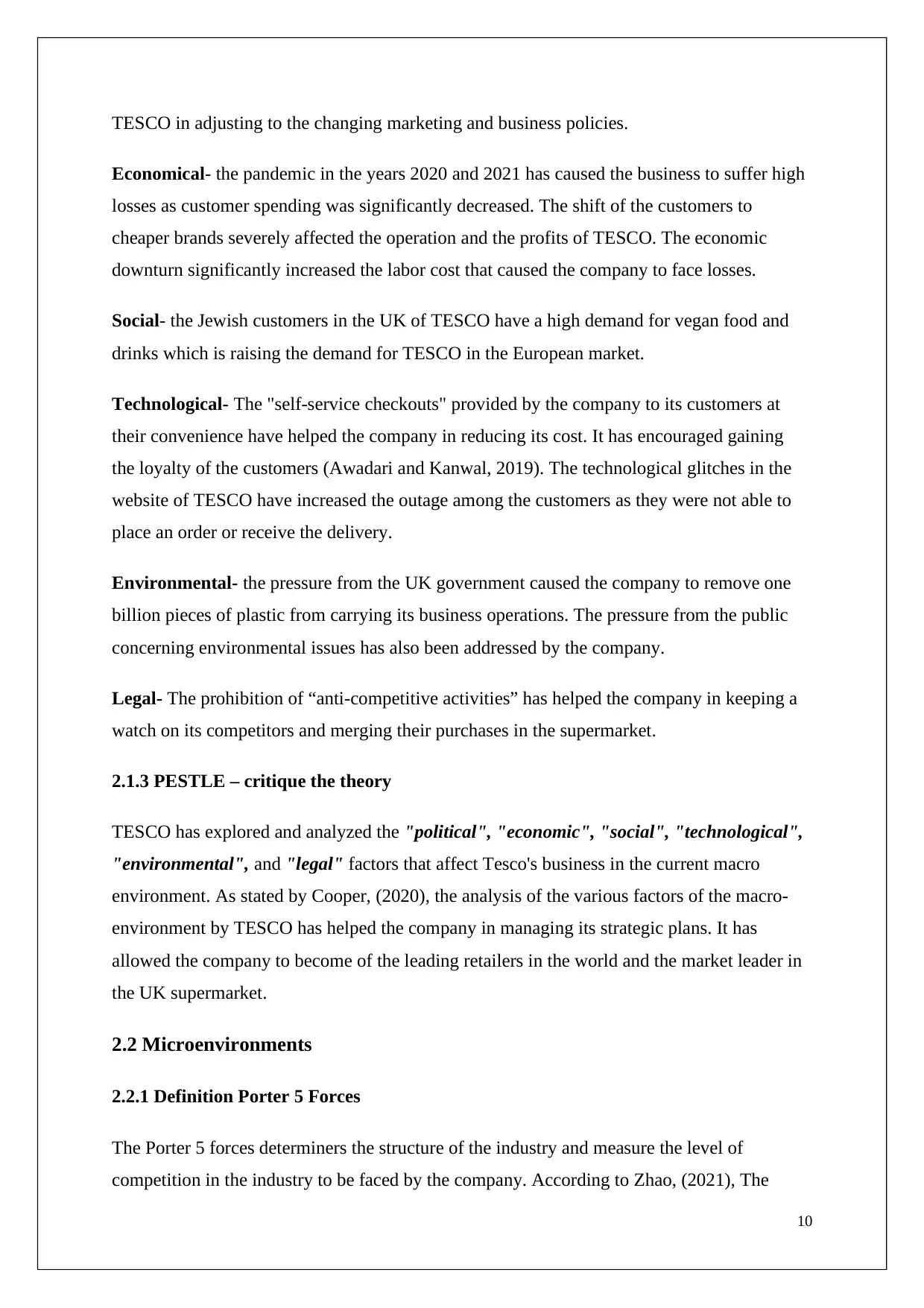
TESCO in adjusting to the changing marketing and business policies.
Economical- the pandemic in the years 2020 and 2021 has caused the business to suffer high
losses as customer spending was significantly decreased. The shift of the customers to
cheaper brands severely affected the operation and the profits of TESCO. The economic
downturn significantly increased the labor cost that caused the company to face losses.
Social- the Jewish customers in the UK of TESCO have a high demand for vegan food and
drinks which is raising the demand for TESCO in the European market.
Technological- The "self-service checkouts" provided by the company to its customers at
their convenience have helped the company in reducing its cost. It has encouraged gaining
the loyalty of the customers (Awadari and Kanwal, 2019). The technological glitches in the
website of TESCO have increased the outage among the customers as they were not able to
place an order or receive the delivery.
Environmental- the pressure from the UK government caused the company to remove one
billion pieces of plastic from carrying its business operations. The pressure from the public
concerning environmental issues has also been addressed by the company.
Legal- The prohibition of “anti-competitive activities” has helped the company in keeping a
watch on its competitors and merging their purchases in the supermarket.
2.1.3 PESTLE – critique the theory
TESCO has explored and analyzed the "political", "economic", "social", "technological",
"environmental", and "legal" factors that affect Tesco's business in the current macro
environment. As stated by Cooper, (2020), the analysis of the various factors of the macro-
environment by TESCO has helped the company in managing its strategic plans. It has
allowed the company to become of the leading retailers in the world and the market leader in
the UK supermarket.
2.2 Microenvironments
2.2.1 Definition Porter 5 Forces
The Porter 5 forces determiners the structure of the industry and measure the level of
competition in the industry to be faced by the company. According to Zhao, (2021), The
10
Economical- the pandemic in the years 2020 and 2021 has caused the business to suffer high
losses as customer spending was significantly decreased. The shift of the customers to
cheaper brands severely affected the operation and the profits of TESCO. The economic
downturn significantly increased the labor cost that caused the company to face losses.
Social- the Jewish customers in the UK of TESCO have a high demand for vegan food and
drinks which is raising the demand for TESCO in the European market.
Technological- The "self-service checkouts" provided by the company to its customers at
their convenience have helped the company in reducing its cost. It has encouraged gaining
the loyalty of the customers (Awadari and Kanwal, 2019). The technological glitches in the
website of TESCO have increased the outage among the customers as they were not able to
place an order or receive the delivery.
Environmental- the pressure from the UK government caused the company to remove one
billion pieces of plastic from carrying its business operations. The pressure from the public
concerning environmental issues has also been addressed by the company.
Legal- The prohibition of “anti-competitive activities” has helped the company in keeping a
watch on its competitors and merging their purchases in the supermarket.
2.1.3 PESTLE – critique the theory
TESCO has explored and analyzed the "political", "economic", "social", "technological",
"environmental", and "legal" factors that affect Tesco's business in the current macro
environment. As stated by Cooper, (2020), the analysis of the various factors of the macro-
environment by TESCO has helped the company in managing its strategic plans. It has
allowed the company to become of the leading retailers in the world and the market leader in
the UK supermarket.
2.2 Microenvironments
2.2.1 Definition Porter 5 Forces
The Porter 5 forces determiners the structure of the industry and measure the level of
competition in the industry to be faced by the company. According to Zhao, (2021), The
10
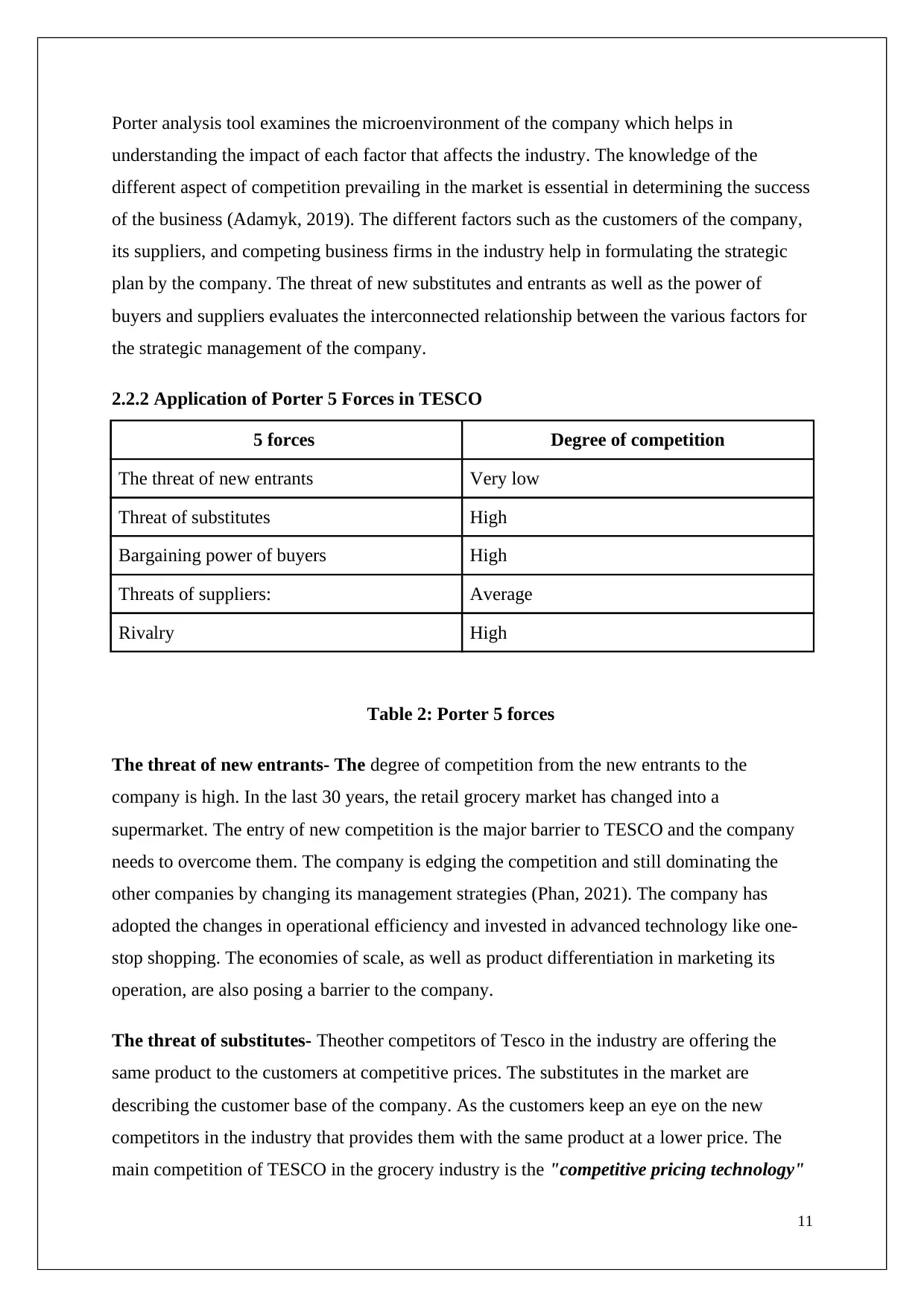
Porter analysis tool examines the microenvironment of the company which helps in
understanding the impact of each factor that affects the industry. The knowledge of the
different aspect of competition prevailing in the market is essential in determining the success
of the business (Adamyk, 2019). The different factors such as the customers of the company,
its suppliers, and competing business firms in the industry help in formulating the strategic
plan by the company. The threat of new substitutes and entrants as well as the power of
buyers and suppliers evaluates the interconnected relationship between the various factors for
the strategic management of the company.
2.2.2 Application of Porter 5 Forces in TESCO
5 forces Degree of competition
The threat of new entrants Very low
Threat of substitutes High
Bargaining power of buyers High
Threats of suppliers: Average
Rivalry High
Table 2: Porter 5 forces
The threat of new entrants- The degree of competition from the new entrants to the
company is high. In the last 30 years, the retail grocery market has changed into a
supermarket. The entry of new competition is the major barrier to TESCO and the company
needs to overcome them. The company is edging the competition and still dominating the
other companies by changing its management strategies (Phan, 2021). The company has
adopted the changes in operational efficiency and invested in advanced technology like one-
stop shopping. The economies of scale, as well as product differentiation in marketing its
operation, are also posing a barrier to the company.
The threat of substitutes- Theother competitors of Tesco in the industry are offering the
same product to the customers at competitive prices. The substitutes in the market are
describing the customer base of the company. As the customers keep an eye on the new
competitors in the industry that provides them with the same product at a lower price. The
main competition of TESCO in the grocery industry is the "competitive pricing technology"
11
understanding the impact of each factor that affects the industry. The knowledge of the
different aspect of competition prevailing in the market is essential in determining the success
of the business (Adamyk, 2019). The different factors such as the customers of the company,
its suppliers, and competing business firms in the industry help in formulating the strategic
plan by the company. The threat of new substitutes and entrants as well as the power of
buyers and suppliers evaluates the interconnected relationship between the various factors for
the strategic management of the company.
2.2.2 Application of Porter 5 Forces in TESCO
5 forces Degree of competition
The threat of new entrants Very low
Threat of substitutes High
Bargaining power of buyers High
Threats of suppliers: Average
Rivalry High
Table 2: Porter 5 forces
The threat of new entrants- The degree of competition from the new entrants to the
company is high. In the last 30 years, the retail grocery market has changed into a
supermarket. The entry of new competition is the major barrier to TESCO and the company
needs to overcome them. The company is edging the competition and still dominating the
other companies by changing its management strategies (Phan, 2021). The company has
adopted the changes in operational efficiency and invested in advanced technology like one-
stop shopping. The economies of scale, as well as product differentiation in marketing its
operation, are also posing a barrier to the company.
The threat of substitutes- Theother competitors of Tesco in the industry are offering the
same product to the customers at competitive prices. The substitutes in the market are
describing the customer base of the company. As the customers keep an eye on the new
competitors in the industry that provides them with the same product at a lower price. The
main competition of TESCO in the grocery industry is the "competitive pricing technology"
11
⊘ This is a preview!⊘
Do you want full access?
Subscribe today to unlock all pages.

Trusted by 1+ million students worldwide
1 out of 37
Related Documents
Your All-in-One AI-Powered Toolkit for Academic Success.
+13062052269
info@desklib.com
Available 24*7 on WhatsApp / Email
![[object Object]](/_next/static/media/star-bottom.7253800d.svg)
Unlock your academic potential
Copyright © 2020–2025 A2Z Services. All Rights Reserved. Developed and managed by ZUCOL.


